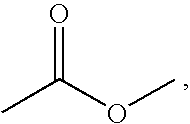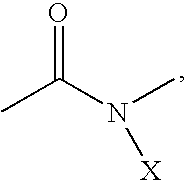Gelatin coated receiver as protein microarray substrate
a technology of protein microarrays and receivers, applied in the field of fabricating protein microarrays, can solve the problems of low manufacturing efficiency, loss of biological activity, and inapplicability of protein microarray applications, and achieve the effect of low cost and easy manufacturing
- Summary
- Abstract
- Description
- Claims
- Application Information
AI Technical Summary
Benefits of technology
Problems solved by technology
Method used
Image
Examples
example 1
This example illustrates the formulation of interlayer and upper gelatin melts and the method of coating the melts onto a glass support. It illustrates the usefulness of using an interlayer to provide the needed adhesiveness of binding gelatin onto a glass surface.
Formulation 1-1 (Gelatin Melt):
Solution 1 :This was prepared by adding 726.54 grams of swollen Type IV gelatin (24.8% w / v) in 2237.06 grams of water, 16 grams of coating aid of Nonylphenoxypolyglycerol, 20.4 grams of coating aid Sodium octyl phenol poly (etheneoxy) sulfonate.
Solution 2: This was prepared by adding 800.79 grams of Ethene, 1,1′-(methylenebis(sulfonyl))bis (1.8% w / v) and 2199 grams of distilled water.
Solution 1 and solution 2 are mixed in equal volume to make into a single melt before coating.
Formulation 1-2 (Interlayer Melt):
This was prepared by adding 2.5 grams of gelatin, 16.3 grams of chrom-alum, 34.7 grams of methanol, 12.7 grams of sodium silicate in 33.9 grams of distilled water.
Control:...
example 2
This example illustrates the method of evaluating gelatin coated protein microarray substrate using a modified enzyme linked immunosobent assay (ELISA).
The procedure to perform the modified ELISA is follows.
1. Goat anti-mouse antibody IgG from Sigma was dissolved in PBS (phosphate saline buffer, pH7.4) buffer to a concentration of 1 mg / mL. A series of diluted of goat anti-mouse antibody IgG were spotted manually onto nitrocellulose membrane and coated gelatin substrates. The spotted substrates were incubated in a humid chamber for 1 hour at room temperature.
2. The substrates were washed four times in PBS buffer with 1% Triton X100™, 5 min each time with shaking.
3. The washed substrates were incubated in PBS buffer with 1% glycine for 15 min with constant shaking.
4. The substrates were washed four times in PBS buffer with 1% Triton™ X100 with shaking.
5. Mouse IgG from Sigma was diluted in PBS buffer with 0.1% Tween™ 20 to 1 μg / mL to cover the whole surface of substrates,...
PUM
| Property | Measurement | Unit |
|---|---|---|
| Thickness | aaaaa | aaaaa |
| Thickness | aaaaa | aaaaa |
| Thickness | aaaaa | aaaaa |
Abstract
Description
Claims
Application Information
 Login to View More
Login to View More - R&D
- Intellectual Property
- Life Sciences
- Materials
- Tech Scout
- Unparalleled Data Quality
- Higher Quality Content
- 60% Fewer Hallucinations
Browse by: Latest US Patents, China's latest patents, Technical Efficacy Thesaurus, Application Domain, Technology Topic, Popular Technical Reports.
© 2025 PatSnap. All rights reserved.Legal|Privacy policy|Modern Slavery Act Transparency Statement|Sitemap|About US| Contact US: help@patsnap.com



